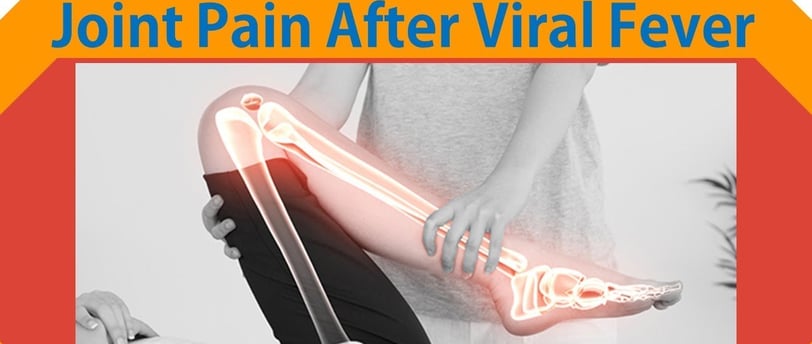Relieving Joint Pain After Viral Fever with Homeopathy: A Holistic and Individualized Approach
Dr. Farheen Choudhary (BHMS, MSW,ADPH)
9/16/20244 min read


Viral infections like dengue, chikungunya, or even common flu can leave lasting discomfort long after the fever subsides. One of the most persistent aftereffects is joint pain, which can be debilitating and frustrating. While conventional painkillers may offer temporary relief, they often mask the symptoms rather than addressing the root cause. This is where homeopathy shines—by offering a holistic, individualized approach to healing post-viral joint pain and supporting long-term recovery.
Understanding Post-Viral Joint Pain
After viral infections, many people experience lingering joint pain and inflammation, often referred to as post-viral arthritis or post-viral fatigue syndrome. The body’s immune response to the infection can trigger inflammation in the joints, resulting in stiffness, swelling, and pain that may last for weeks or months.
Homeopathy offers a natural solution by addressing the root cause of the inflammation and supporting the body’s recovery process. However, it’s important to note that homeopathy is highly individualized, meaning treatment is tailored to each person’s specific symptoms, constitution, and overall health.
1. The Power of Individualized Treatment
One of the core principles of homeopathy is that no two patients are the same, even if they exhibit similar symptoms. A group of patients may all experience joint pain after a viral fever, but each person’s pain may have unique characteristics. For instance, some might have joint pain that worsens with movement, while others find relief by staying active. In homeopathy, we carefully analyze these subtle differences to prescribe a remedy that fits the individual, not just the condition.
For example:
Bryonia is typically prescribed for patients whose joint pain worsens with movement and improves with rest.
Conversely, Rhus Toxicodendron is ideal for those whose joint pain improves with movement but worsens after resting or sitting still for long periods.
Even though patients may present similar post-viral joint symptoms, their individual remedy choices differ based on their unique experience and overall constitution. This individualized approach ensures that each person’s remedy is specific to their body, leading to more effective and long-lasting results.
2. Restoring Balance to Inflammation and Joint Pain
Joint pain after a viral fever is often due to residual inflammation. Unlike conventional medications, which only suppress inflammation, homeopathy encourages the body to heal itself by working with its natural mechanisms.
Bryonia is often used for sharp, stiff joint pain that gets worse with movement, particularly when the joints are swollen and tender.
Rhus Toxicodendron is highly effective for joint pain that improves with movement and gets worse in cold or damp conditions, especially when stiffness is severe after rest.
It’s important to remember that even if two people have similar symptoms, their treatment in homeopathy will be different based on their individuality. These remedies go beyond simply easing the pain; they help restore the body’s natural balance, addressing both the physical symptoms and the underlying causes.
3. Supporting Recovery from Weakness and Fatigue
Post-viral joint pain is often accompanied by overwhelming weakness and fatigue. The body may be drained after fighting off the infection, making the recovery process slower. Homeopathy addresses this fatigue by restoring the body’s vitality in addition to relieving joint pain.
Gelsemium is recommended for patients who feel sluggish, heavy, and weak after a viral illness, with accompanying muscle and joint pain.
China Officinalis is ideal for those feeling weak and dehydrated after a fever, especially when accompanied by joint pain and exhaustion.
These remedies not only focus on reducing pain but also help patients regain their strength and energy. Again, the remedy is individualized, meaning that although two people may both feel fatigue and joint pain, they may require different remedies based on their overall health and specific symptoms.
4. Preventing Chronic Joint Problems Post-Viral Infection
For some, joint pain after a viral fever can become chronic, leading to long-term joint issues. Homeopathy aims not just to relieve immediate pain but also to prevent the development of chronic conditions by treating the root cause of inflammation and strengthening the body’s immune response.
Ledum Palustre is effective for persistent joint pain, particularly in the lower limbs, that can linger after the viral fever subsides. It helps reduce inflammation and prevents long-term joint damage.
Calcarea Carbonica is used for individuals who frequently experience joint pain after any illness. It strengthens the body and prevents recurring joint inflammation.
Again, even if the condition seems the same, individualization in treatment is key. Remedies are selected based on the person’s unique constitution and overall health, ensuring long-term relief and prevention.
5. Natural, Safe Relief Without Side Effects
Homeopathy offers a gentle, safe option for individuals of all ages, including children and the elderly. Post-viral joint pain can affect anyone, and homeopathic remedies provide relief without the side effects of conventional painkillers. Whether it's a child recovering from a viral illness or an older adult dealing with lingering joint pain, homeopathy works harmoniously with the body’s healing processes.
6. Addressing Mental and Emotional Strain
Post-viral conditions often take a toll on mental health as well, with patients feeling emotionally drained or anxious after an illness. Homeopathy considers these emotional aspects in the healing process, offering remedies that support both physical and mental recovery. Ignatia is often prescribed for patients who feel emotionally overwhelmed or anxious after recovering from an illness, while Kali Phosphoricum can help those feeling mentally fatigued and stressed. By addressing both the mind and body, homeopathy ensures holistic recovery, helping patients regain their full health and well-being.
It’s essential to remember that homeopathic treatment is personalized. While similar symptoms may be present in different individuals, the remedies used will differ based on the person’s unique constitution and health profile. Joint pain after a viral fever can be difficult to manage, but with homeopathy’s individualized approach, you can find natural, effective relief. By addressing the root cause of inflammation, supporting recovery, and preventing chronic issues, homeopathy offers long-lasting healing without the side effects of conventional treatments.